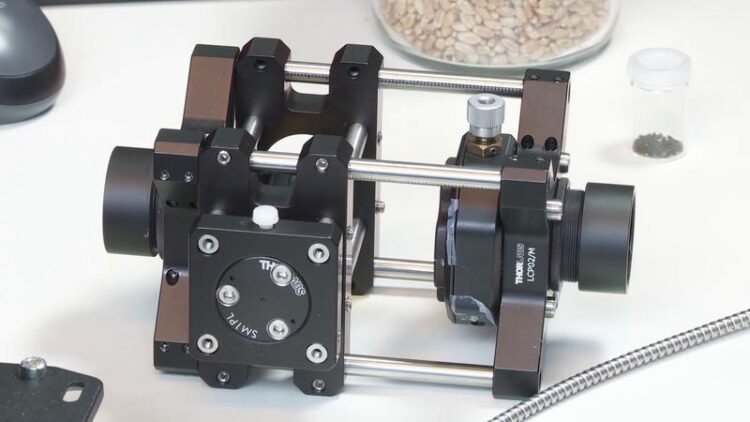Laser Technology for Agriculture 4.0

Harmful pests are rendered harmless with the laser system.
© Fraunhofer IZM
With climate change, uncertainties in food security, and pressure to preserve resources, agriculture is facing difficult tasks. To meet these challenges with cost-effective and intelligent electronic solutions, researchers at Fraunhofer IZM are working with partners to combine smart system integration with sensor technology, thus enabling the leap to Agriculture 4.0. In an earlier project they developed a laser that uses optical detection and AI evaluation to prevent infestation with harmful insects in warehouses and that is intended to replace the usual fumigation.
Between the cultivation of grain and its consumption lies the real work of farmers. The growth of the plants must be continually monitored, the soil quality checked, and harmful insects eliminated — processes that cost both time and money.
To modernize them, Fraunhofer Institute for Reliability and Integration IZM and the TU Berlin are involved in the ZIM network “AgriPhotonik” which brings together 29 German and Israeli partners from industry and research to establish digital processes in agriculture by using the potential of agricultural technology and photonics. The network management is handled by the OpTecBB competence network.
In the precursor project “Insect Laser”, supported by the Federal Office for Agriculture and Food and partners, a solution was developed at Fraunhofer IZM to protect the agricultural stock from contamination by grain weevils and Indian meal moths. Though barely four millimeters long, these pests can cause significant economic damage and carry diseases.
It is common practice to fumigate storage spaces with chemicals only after an infestation with harmful insects. These chemicals, such as hydrogen phosphide, are deadly to the insects but can be used only sparingly. When used more frequently, residues on the stock can cause health hazards to humans and, above all, environmental pollution.
To reduce the use of chemical protective agents, the researchers at the Fraunhofer Institute for Reliability and Integration IZM set out to combine laser technology and automated image recognition to reliably ensure the safety of agricultural products. The project was coordinated by the Julius Kühn Institute in Berlin.
The researchers detect the moment of infestation before the pests can spread throughout the stocks. Using an image-processing method developed by the BTU Cottbus (Brandenburgische Technische Universität Cottbus), the small pests are detected on the surface of the supplies or on walls. An AI system then analyzes and classifies the insects and compares them against reference images. Such algorithms for image recognition are already established in countless applications. In this project, however, the wide variety of dimensions was especially challenging, since harmful insects that are only a few millimeters in size need to be reliably detected in the warehouses. This had to be taken into account in the design and production of the IZM laser system.
Once the position of a pest is known, a fine laser beam is directed to the relevant coordinates via radio by a scanner, rendering the corn weevil or Indian meal moth harmless. Because of the low temperature and intensity of the laser, the grains located underneath are unaffected. By using a laser system, direct primary infestation is prevented, so that insects harmful to supplies do not spread in the first place.
The Fraunhofer IZM researchers in Berlin examined how different wavelengths and light beam intensities influenced the movement behavior of the pests and found that the infrared light had the lowest effect on the characteristic movement behavior used to identify the animals. The researchers were also significantly involved in developing the laser system, and initially created a laboratory setup. Following successful testing, they transferred this set-up into a compact insect laser system consisting of several units for use in test cells. They also developed the interfaces for software and hardware between camera, laser, and scanner.
With these activities, Fraunhofer IZM is opening up to projects that will increase digitalization and automation in agriculture. In doing so, the researchers integrate optical sensors and electronic controls into unique systems and ensure that these can be manufactured efficiently and used sustainably.
(Text: Olga Putsykina)
Wissenschaftliche Ansprechpartner:
Dr. Gunnar Böttger l Phone +49 30 46403-644 l gunnar.boettger@izm.fraunhofer.de |
Fraunhofer Institute for Reliability and Microintegration IZM I Gustav-Meyer-Allee 25 | 13355 Berlin
Originalpublikation:
https://www.izm.fraunhofer.de/en/news_events/tech_news/laser-technology-for-agri…
Media Contact
All latest news from the category: Agricultural and Forestry Science
Newest articles

NASA: Mystery of life’s handedness deepens
The mystery of why life uses molecules with specific orientations has deepened with a NASA-funded discovery that RNA — a key molecule thought to have potentially held the instructions for…

What are the effects of historic lithium mining on water quality?
Study reveals low levels of common contaminants but high levels of other elements in waters associated with an abandoned lithium mine. Lithium ore and mining waste from a historic lithium…

Quantum-inspired design boosts efficiency of heat-to-electricity conversion
Rice engineers take unconventional route to improving thermophotovoltaic systems. Researchers at Rice University have found a new way to improve a key element of thermophotovoltaic (TPV) systems, which convert heat…



